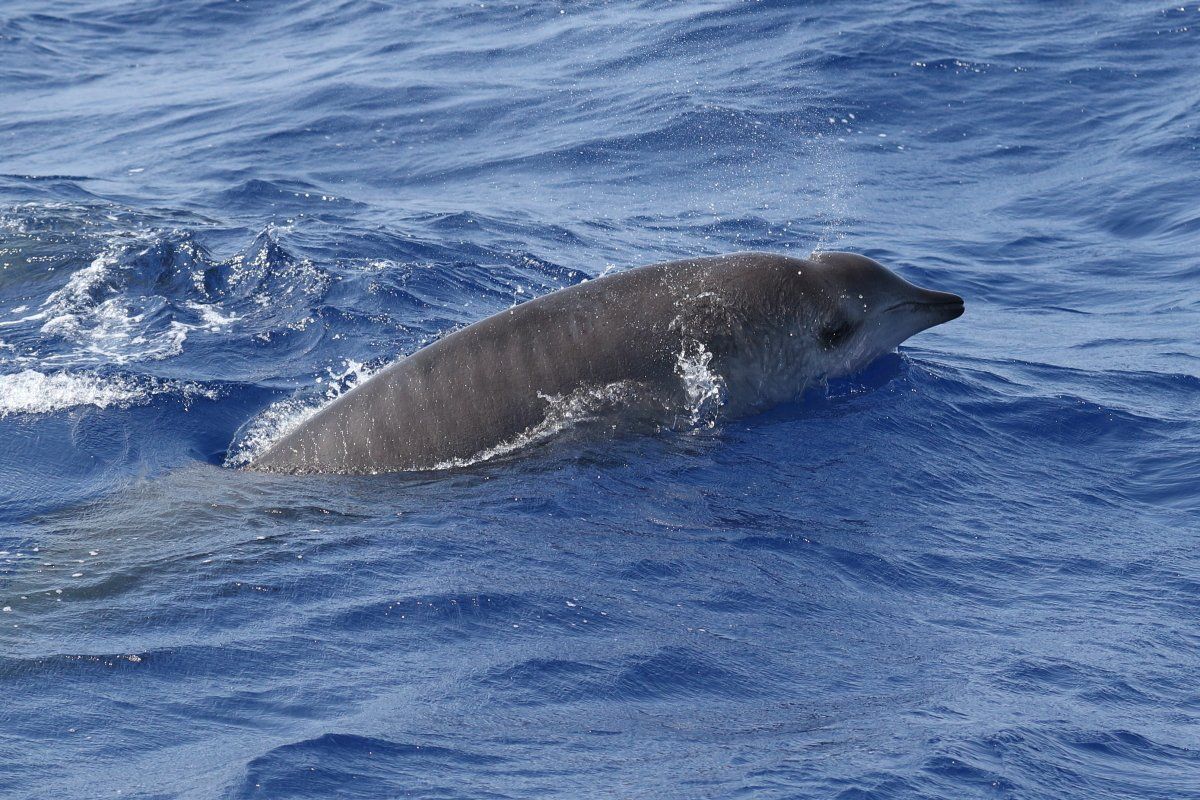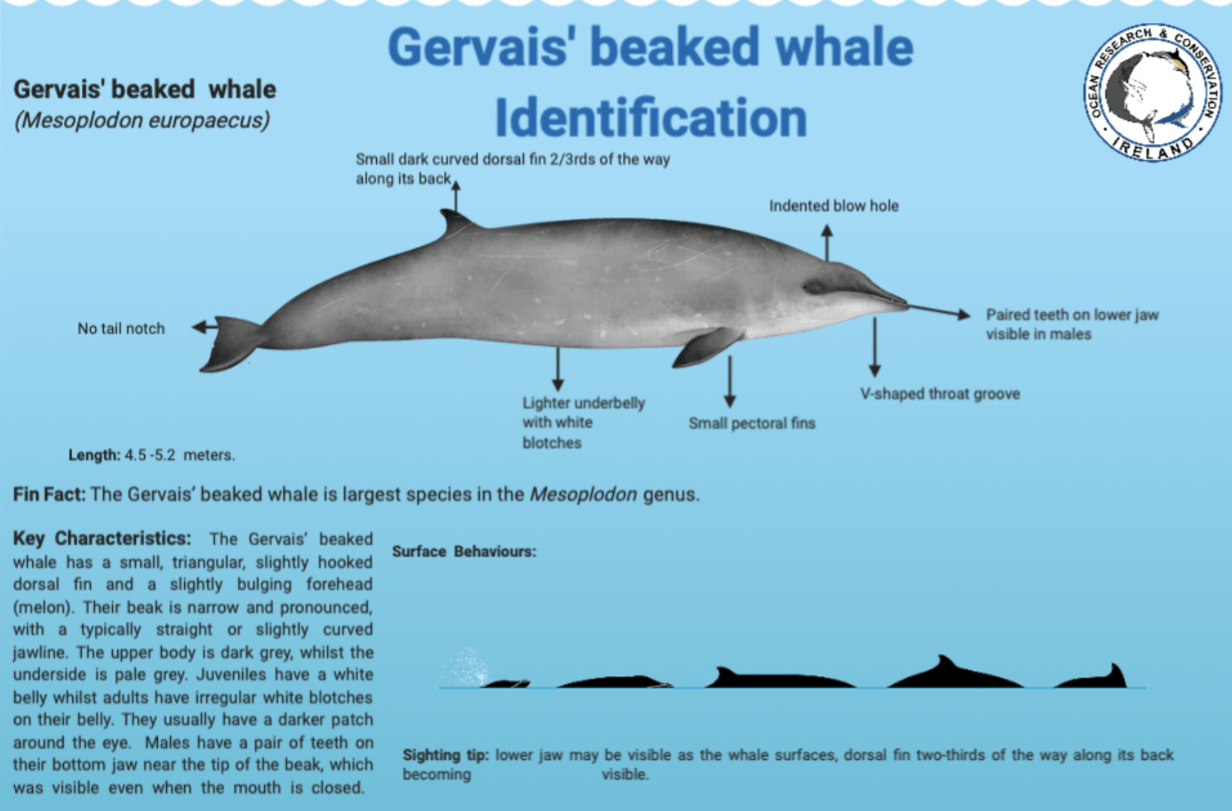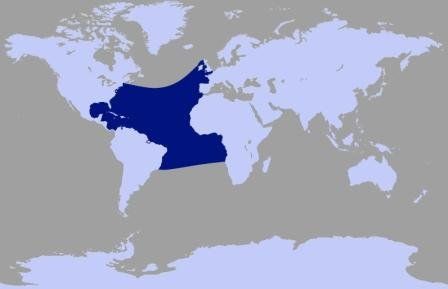Gervais' beaked whale
(Mesoplodon europaeus)
Classification:
Kingdom: Animalia
Phylum: Chordata
Class: Mammalia
Order: Artiodactyla
Infraorder: Cetacea
Family: Ziphiidae
Genus: Mesoplodon
Species: M. europaeus
Get the facts:
The Gervais’ beaked whale is largest species in the Mesoplodon genus. In the 1830s, a floating animal was found in the English Channel by a ship owned by the French merchant and armorer, Abel Vautier. The captain of the ship cut the animals head off and gave it to Vautier. It then was described as a new species in 1855 by the French scientist, Paul Gervais. Very little is known about this whale, with only strandings and a few sightings providing details about this species.
Species identification:
Species in the Mesoplodon genus are often difficult to distinguish from one another because they lack easily visible physical characteristics. The Gervais’ beaked whale has a small, triangular, slightly hooked dorsal fin and a slightly bulging forehead (melon). Their beak is narrow and pronounced, with a typically straight or slightly curved jawline. The upper body is dark grey, whilst the underside is pale grey. Juveniles have a white belly whilst adults have irregular white blotches on their belly. They usually have a darker patch around the eye. Males are 4.5m in length, whereas females are 5.2m. Calves are believed to be 2.1m. Males have a pair of teeth on their bottom jaw near the tip of the beak, which was visible even when the mouth is closed.
Diet:
They are deep divers, feeding primarily on squid, but also small fish.
Habitat:
Strandings and the few confirmed sightings suggest that the Gervais’ beaked whale is found in tropical and subtropical waters. The species presence in Irish waters was confirmed by one stranded animal in Ballysadare Bay, Co. Sligo in 1989. Little is known about this species presence in Irish waters.
Behaviour:
Like other beaked whales, the Gervais’ beaked whale is a deep diver, making it hard to study their behaviour in depth. They appear to stay low profile and display skittish behaviour. They surface blow is small and inconspicuous. They briefly surface for air before diving, with dives estimated to last around an hour.
Social Structure:
It is believed that they live in small groups or pairs, judging by stranding’s. Scaring on males suggests they may fight to compete for a mate.
Reproduction:
Females become sexually mature at around 4.5m, giving bird to a single calf that is roughly 2m in length and weighing about 80kg.
Vocalisations:
A study in 2008 found that the Gervais’ beaked whale’s vocalisations were mostly between 30-50kHz, a higher frequency than the more well studied Cuvier’s and Blainville’s beaked whales.
Lifespan:
The lifespan for this species is estimated to be at least 27 years, but one specimen was found to be 48 years old.
Global distribution:
Since the discovery of this species, it has been found off the eastern coast of the USA, Ireland, the Canary Islands, western Africa and Ascension Island. Most strandings and sightings have occurred in the western Atlantic. One specimen has even been found as far south as Sao Paulo, Brazil.
Population Status:
The Gervais’ beaked whale is Data Deficient on the IUCN Red List of Endangered Species. It is the most commonly sighted species in the Mesoplodon genus off the eastern coast of the USA and the Gulf of Mexico. In 2006, it was estimated that around 106 Mesoplodonts occur in the northern Gulf of Mexico, which were considered to be either Gervais’ beaked whale or Blainville’s beaked whale. It has been suggested that this species may be naturally rare.
Threats to Survival:
Due to their deep diving behaviour, Gervais’ beaked whale may be sensitive to underwater sounds and man-made noise. Sound pollution may interrupt their normal behaviour. A juvenile was found dead on a beach in Puerto Rico, with around 4kg of plastic bags in its stomach, suggesting plastic pollution may also threaten these species. A few whales have also accidentally been caught a bycatch in fishing gear. Hunting is not thought to threaten the Gervais’ beaked whale, but it cannot be ruled out as a potential threat.






